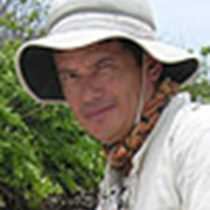Bartolomé & Puerto Egas, Santiago
Today was a very long day. It began early in the morning and finished late in the afternoon, just before the last silver lining. As soon as I saw the island in the morning, with the big puffy clouds overhead, I knew the rainy season had begun: a blessing for the most famous inhabitant of Bartolomé, the lava lizard. But while some animals were relieved by this arrival, as soon as I read the sea temperature this morning at 76 degrees Fahrenheit, I knew that penguins would not be seen: in Galápagos, conditions that are good for land animals are usually bad for sea animals and vice versa.
Bartolomé is most famous because of the pinnacle rock. The most famous picture of this is taken from the top of the islet after a heart-pumping climb up, and moreover it is famous for its beautiful moonscape. It is the geologist’s paradise, looking as though time has stopped giving us a demonstration of how nature worked way, way before we came along. Petrified lava pours down from the top, small craters that are vertical with respect to the slope of the main volcano give us an idea this place was boiling a long time ago.
After breakfast we walked across the other face of Bartolomé, over the sand dunes, in order to visit a sandy beach on the South side. There, near the coastline we saw a white tipped reef shark swimming quietly by, and on the beach we observed many of the interesting plants of the coastal zone and lots of sea turtles tracks. Returning to the beach at Pinnacle Rock, many of us swam into the waters to snorkel, observing rays and lots of colorful fish, but no penguins, as it was way too warm for them.
In the afternoon we traveled to Puerto Egas, where it was raining but the sea was very calm. One can note immediately that there is evidence of human activity at this site. Salt had been mined nearby periodically for almost 200 years. An abandoned house and tanks are left over from the most recent mining episode in the early 1960’s. This is one of the few sites, specifically in the grottos, that a breeding colony of Galápagos fur sea lions can be seen; today we saw them side-by-side with Galápagos sea lions; moreover large numbers of migrant and resident birds. We saw how water like small rivers came down along the slope of the sugar loaf hill, giving as another example of how nature works, relentlessly eroding rocks.
The snorkeling was excellent; we saw sharks, sea turtles and sea lions chasing fish. From underwater looking up I saw raindrops falling from the sky onto the surface, reminding me of my childhood, and how still now I love rainfalls and swimming in them.
Today was a very long day. It began early in the morning and finished late in the afternoon, just before the last silver lining. As soon as I saw the island in the morning, with the big puffy clouds overhead, I knew the rainy season had begun: a blessing for the most famous inhabitant of Bartolomé, the lava lizard. But while some animals were relieved by this arrival, as soon as I read the sea temperature this morning at 76 degrees Fahrenheit, I knew that penguins would not be seen: in Galápagos, conditions that are good for land animals are usually bad for sea animals and vice versa.
Bartolomé is most famous because of the pinnacle rock. The most famous picture of this is taken from the top of the islet after a heart-pumping climb up, and moreover it is famous for its beautiful moonscape. It is the geologist’s paradise, looking as though time has stopped giving us a demonstration of how nature worked way, way before we came along. Petrified lava pours down from the top, small craters that are vertical with respect to the slope of the main volcano give us an idea this place was boiling a long time ago.
After breakfast we walked across the other face of Bartolomé, over the sand dunes, in order to visit a sandy beach on the South side. There, near the coastline we saw a white tipped reef shark swimming quietly by, and on the beach we observed many of the interesting plants of the coastal zone and lots of sea turtles tracks. Returning to the beach at Pinnacle Rock, many of us swam into the waters to snorkel, observing rays and lots of colorful fish, but no penguins, as it was way too warm for them.
In the afternoon we traveled to Puerto Egas, where it was raining but the sea was very calm. One can note immediately that there is evidence of human activity at this site. Salt had been mined nearby periodically for almost 200 years. An abandoned house and tanks are left over from the most recent mining episode in the early 1960’s. This is one of the few sites, specifically in the grottos, that a breeding colony of Galápagos fur sea lions can be seen; today we saw them side-by-side with Galápagos sea lions; moreover large numbers of migrant and resident birds. We saw how water like small rivers came down along the slope of the sugar loaf hill, giving as another example of how nature works, relentlessly eroding rocks.
The snorkeling was excellent; we saw sharks, sea turtles and sea lions chasing fish. From underwater looking up I saw raindrops falling from the sky onto the surface, reminding me of my childhood, and how still now I love rainfalls and swimming in them.




